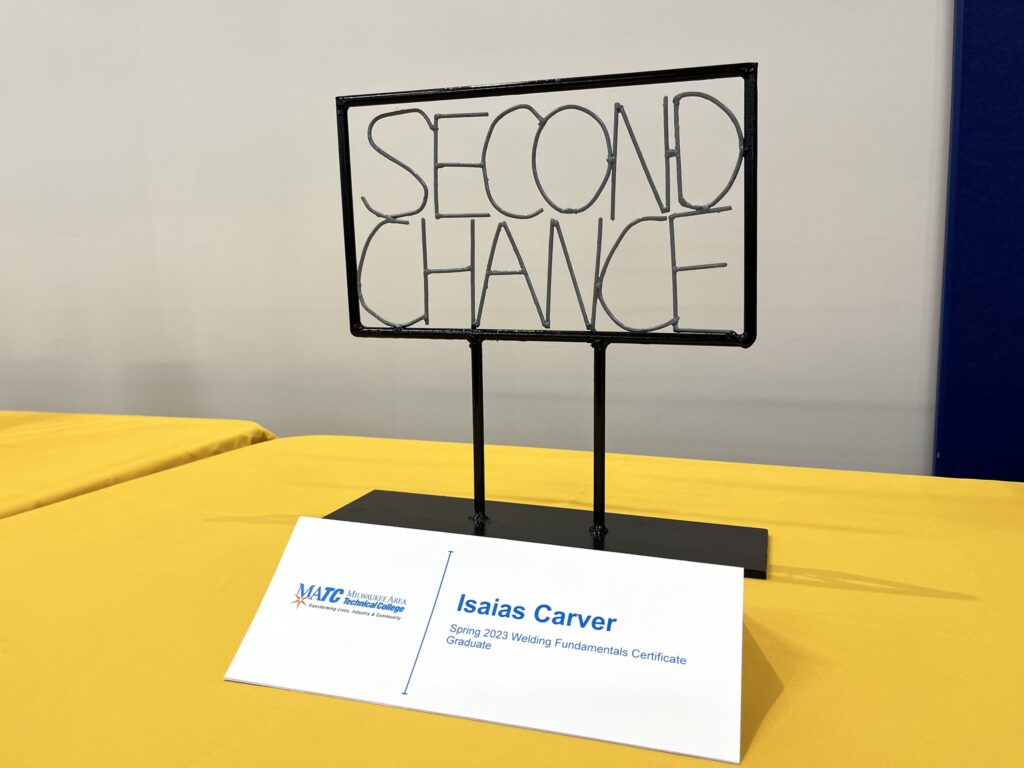MATC Program Teaches Welding To Those Incarcerated
Certificate program provides job opportunities after release, pathway to full degree.

A completed welding project by Isaias Carver is displayed during the graduation ceremony for the welding fundamentals certificate program. The program trains students in the core basics of welding, preparing them for entry-level work. Photo by Devin Blake/NNS.
Generally, the unemployment rate for people who have been incarcerated is sky high.
An analysis by the Prison Policy Initiative, for example, found formerly incarcerated people are unemployed at a rate of over 27%. That’s higher than the total U.S. unemployment rate during any historical period, including the Great Depression, according to the report.
But the men who graduated recently with a welding fundamentals certificate from Milwaukee Area Technical College, or MATC, will almost certainly not have that problem.
A trade like welding, said Isaias Carver, “will just put me in a better spot.”
Carver was one of the five people who graduated with a welding fundamentals certificate as part of MATC’s Second Chance Pell Grant program, which provides federal funding for students who are incarcerated.
During the 16-week program, students learn the skills needed for basic production welding, said David Lunz, an instructor in the Manufacturing, Construction and Transportation Academic Pathway at MATC.
An in-demand job
Welders are vital to many industries, including construction, automotive and manufacturing.
“This certificate gives them pretty much everything they need … to go into a job interview and pass a welding test and a blueprint test for a basic entry-level job,” Lunz said.
Students who earn their welding fundamentals certificate can continue their training at MATC by pursuing a technical diploma or associate degree, said Sadique Isahaku, MATC’s dean of General Education Academic & Career Pathway.
During the graduation ceremony in May, Kevin Carr, secretary for the Wisconsin Department of Corrections, told the men that “demand for skilled workers like you is high.”
Exact estimates vary, but the average hourly post-release wage for those who have completed a welding program like MATC’s is above $20, Carr said.
What the grads say
Carver said he particularly enjoyed discovering the science behind welding.
“I’m learning what electrodes to use, to different positions, to following blueprints to make a project,” he said.
James Tombs, another May graduate, said he was proud he completed the program.
“The finished product – once you see something that you made with your hands … I can’t explain it. It’s a sense of accomplishment,” he said.
Lunz said his students know that the program offers them a rare opportunity.
“They’re not just coming here to get out of jail,” he said. “They’re actually putting in the work, and they’re interested in learning. They’re real eager to learn.”
For more information
The Second Chance Pell Grant program is for students who are incarcerated, but people who would like to learn about it can go to MATC’s webpage.
More information about the welding program at MATC in general also is available.
Devin Blake is the criminal justice reporter for the Milwaukee Neighborhood News Service. His position is funded by the Public Welfare Foundation, which plays no role in editorial decisions in the NNS newsroom.
MATC welding program teaches incarcerated students how to learn-and earn was originally published by the Milwaukee Neighborhood News Service.




















